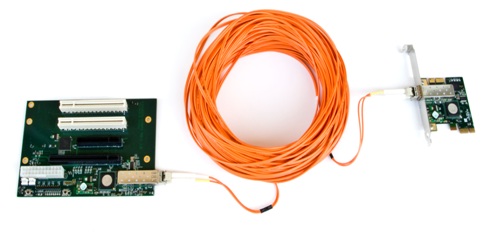Epiphan KVM2USB is a USB device that connects between your (portable) Linux or Windows PC and a headless VGA/XVGA enabled computer, turning the PC as Keyboard, Video Mouse (KVM) of the headless system. The following two pictures illustrates a typical usage:
cots
Monday, March 2, 2009
Laptop as VGA console – second generation got it right!
Posted by M.P. under cots, product evaluation | Tags: kvm |Leave a Comment
Monday, January 26, 2009
Quick testing Adnaco S2 remote PCI / PCI Express fiber kit
Posted by M.P. under cots, hardware, product evaluation | Tags: fiber, pci, pci express |1 Comment
Recently I have been testing Adnaco S2 remote PCI/PCIe (PCI Express) over fiber kit.
Installation
Adnaco has done careful job and there is practically no hick-ups in the installation. At least there is no drivers to install and from the remote host’s point of view the entire operation is really transparent (Trenton MCXT PICMG1.3, motherboard BPX6719). I experienced some problems initially, after the installation when the test system refused to fire up. The problem was obviously related to the fact the remote PCI/PCIe extension chassis was not turned on. Here is a point of improvement, the remote chassis should turn automatically on, when the remote host fires up.
Test Arrangement
To test the performances, I moved the LSI SAS3041 RAID controller of the remote host into the Adnaco S2 extension chassis and replaced its slot with Adnaco’s H1 PCIe/Fiber interface. Between the two chassis I put 50 meters of multi-mode cable. The SFP transceivers are SR (for Short Range) type. As you can see from the below picture, I did not moved the actual SAS disks into the other chassis, there is no scientific reason to do so.. The LSI SAS3041 card is connected with three 15 krpm SAS disks. The embedded LSI controller is not used for RAID operations but the three disks create a software RAID-0 array as /dev/md0 device in Red Hat Linux 5.2 64-bit system. The below picture illustrates the test arrangement.
Performance
We are interested especially in the write performance of the RAID-0 array. We are using basically two tests, each writing big chunks of data of 4 GB into the RAID-0 array. We are not interested of the short cycle read-write operations and that is why I have no measurement data other than block write. The first tests consist of a test program written in C. It creates a memory block and using write() system call moves the 4 GB memory block into the RAID-0 array using Linux /dev/md0 mounted EXT2 file system:
- Local performance: 264 MB/s
- Same test with the LSI controller on remote Adnaco R1BP1: 160 MB/s
That’s great, since it is but 38 percent drop in performance and not 75 percent that could have followed from the fact that we have to switch from four PCI Express lanes into a single lane in the fiber. This means that the performance bottleneck in this particular application is rather in the SAS disk array, the LSI SAS controller and Linux file system and Linux RAID system.
Another test allows us to limit take out the Linux file system performance from the test. It is called “dd test“, from the GNU/Linux dd(1) utility. The test allows to write directly from the memory into the raw device, served by the Linux RAID system. The commands within the (test) script are:
Fill Random
dd if=/dev/random of=/dev/md0 bs=1G count=4
Fill Zero
dd if=/dev/zero of=/dev/md0 bs=1G count=4
Please note that the random filling is used between each /dev/zero test to make it less probable that the LSI device and/or SAS disk can cache the zero stream.
- Local performance: 324 MB/s
- Adnaco R1BP1: 175 MB/s
This is truly a great result from Adnaco! Let me remind you that theoretical maximum speed of one lane PCI Express (first generation) is 2.5 Gbit/s. With 10-bit payload, that makes theoretical transfer speed of 250 MB/s. With Adnaco we get up to 70 percent bandwidth occupation.
Conclusion
I am very satisfied with the above results. I have learned that the oversimplification in performance calculations is bad. You cannot just divide the local performance with the number of lanes when you move from eight lane PCI Express operation to one lane operation. You need to try what actually will happen in your specific problem. There is always so much software and firmware overhead that you have to make a test before you can tell. Adnaco S2 sorts out from the test as a stable product. I would like to see more slots, both PCI and PCI Express on the remote motherboard. The proposed enclosure should not be a “mini-tower” but a 19 inch, rackable, 4U height unit.
Friday, March 14, 2008
1 GB/s detectors – easy peace of cake!
Posted by M.P. under cots, hardware, product evaluationLeave a Comment
If you got a big wallet, that is.
Violin 1010 is the first (and therefore probably out of price) Memory Appliance with mixed DRAM and NAND Flash technology. It provides 504 GB of DRAM in a 2 U chassis. Its PCI-Express interface allows it to be connected directly on the data acquisition system, for example on a Trenton MCXT PICMG-1.3 computer which sports a four lane PCI-Express connection in the front panel. (more…)





You must be logged in to post a comment.